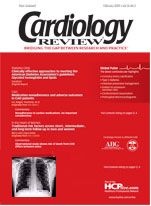The role of inflammation and statin therapy in cardiovascular disease
The study by Schillinger and Minar (page 27) showed a survival benefit for HMG-CoA reductase inhibitor (statin) therapy in patients with peripheral arterial disease and increased high-sensitivity C-reactive protein levels. There was, however, no survival benefit of statins in patients with low high-sensitivity
C-reactive protein levels. These results add to our understanding of inflammation and the presumab-
ly cholesterol-independent effects of statins.
The role of inflammation in atherosclerotic cardiovascular disease
Inflammation plays a pivotal role in all stages of atherosclerosis.1 Adhesion molecules expressed by the inflamed endothelium recruit leu-kocytes, which penetrate into the intima and cause inflammation. Inflammatory mediators enhance uptake of modified lipoprotein particles and formation of lipid-filled macrophages. T cells also enter the intima and secrete cytokines, which amplify the inflammatory response and promote the migration and proliferation of intimal smooth muscle cells. Inflammatory mediators can weaken the protective fibrous cap of the atheroma, leading to plaque rupture, erosion, or fissuring and then to thrombosis and the occurrence of an acute coronary syndrome.
The fact that half of all coronary events occur in persons without overt hyperlipidemia2 has led to
the identification of several novel
inflammatory markers for cardiovascular risk. Of these, C-reactive protein has emerged as the leading candidate marker because of its predictive ability and its wide availability, low cost, and ease of use.3
C-reactive protein is an acute-phase reactant, which has been shown in more than 20 prospective studies to predict myocardial infarction, stroke, peripheral arterial disease, and sudden cardiac death.3 An American Heart Association/Centers for Disease Control and Prevention scientific statement on markers of inflammation and cardiovascular disease endorses the optional use of high-sensitivity C-reactive protein to identify paients at intermediate risk for cardiovascular disease in whom physicians may need additional information to guide further evaluation or therapy.4 The cutoff points for low, intermediate, and high risk are below 1.0 mg/L, 1.0 to 3.0 mg/L, and above 3.0 mg/L, respectively.
The pleiotropic effects of statins
Statin drugs mediate a number of biological actions, called pleiotropic actions, which go beyond the lowering of low-density lipoprotein (LDL) cholesterol. Probable pleiotropic effects of statins include attenuation of endothelial dysfunction, plaque stabilization, a decrease in thrombogenicity, and a blunting of inflammation. These pleiotropic effects may be mediated by statins’ inhibition of isoprenoid production. Isoprenoids are lipid intermediates of cholesterol biosynthesis and important components of signal transduction in many organ systems.5
In subgroup analyses of the Heart Protection Study,6 the relative risk reduction associated with statin therapy was almost identical among those with low as well as high levels of LDL cholesterol. The non—lipid-lowering effects of statins may explain the relatively rapid time course of event reduction in patients at high risk for recurrent coronary ischemia in the Myocardial Ischemia Reduction with Aggressive Cholesterol Lowering (MIRACL) trial.7
Clinical implications for the use of inflammatory markers and statin therapy
There is mounting evidence that the beneficial effect of statin ther-
apy may be greatest in individuals with high inflammatory activity. The Air Force/Texas Coronary Atherosclerosis Prevention Study (AFCAPS/
TexCAPS) was a primary prevention trial of 6,605 men and women taking lovastatin.8 In a post-hoc analysis, among participants with a low LDL cholesterol level and a high C-reactive protein level, the reduction in acute coronary events with lovastatin was virtually identical to that among participants with high LDL cholesterol levels alone. This suggests that statin therapy may be clinically effective in persons with inflammation but no hyperlipid-
emia.9 Similarly, in a nested case-control analysis of 708 patients in the Cholesterol and Recurrent Events (CARE) trial, subjects with increased levels of C-reactive protein bene-
fited more from therapy with pravastatin than those without increased levels of these inflammatory markers.10
Conclusion
Currently, there are no practice guidelines to tailor statin therapy based on high-sensitivity C-reactive protein levels. However, recent modifications to the Adult Treatment Panel guidelines state that, in high-risk persons, the recommended LDL cholesterol goal is below 100 mg/dL but an LDL cholesterol goal of below 70 mg/dL is a therapeutic option.11 Although not explicitly stated, this modification suggests that LDL cholesterol alone may not be the optimal target for statin therapy.
The large-scale Justification for the Use of Statins in Primary Prevention: An Intervention Trial Evaluating Rosuvastatin (JUPITER) trial has been initiated to test the concept that statin therapy should be targeted to patients with evidence of inflammation provided by increased high-sensitivity C-reactive protein levels in the absence of hyperlipidemia.12 The JUPITER trial is randomly assigning adults with LDL cholesterol levels below 130 mg/dL and high-sensitivity C-reactive protein levels 2 mg/L or greater to receive rosuvastatin or placebo. The results of this trial will be useful in further delineating the beneficial effects of statin therapy for their anti-inflammatory, rather than their lipid-lowering, effects. n
